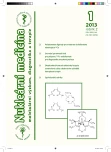The long-term effectivity control of sentinel lymph node biopsy through the follow-up of complex therapy results
Authors:
Milan Šimánek () 1; Václav Abrahám () 2; Jaromír Kořínek () 2
Authors‘ workplace:
Oddělení nukleární medicíny Nemocnice Pelhřimov p. o., ČR
1; Onkologická ambulance Nemocnice Pelhřimov p. o., ČR
2
Published in:
NuklMed 2013;2:13-17
Category:
Original Article
Overview
The aim:
The effectivity evaluation of the sentinel lymph node biopsy and subsequent therapy of the breast carcinoma after the implementation of the method into the clinical practice.
Patients and methods:
From 2006 to 2010, 94 patients with breast carcinoma who underwent the sentinel lymph node biopsy, average age 60,6 years, tumour size up to T2 in TNM classification (85 % T1, 10 % T2,5 % TIS) were included in the follow-up. The sentinel lymph node biopsy was done with the periareolar injection of radiotracers with larger colloid particles. The positive sentinel nodes were found in 27 % of patients, 23 % of which presented by micrometastasis or isolated tumor cells. The axillary dissection was indicated if the sentinel node was positive. The breast irradiation and selectively axilla irradiation were done in 79 %. Subsequently the patients were treated according to the standard protocol and were observed in Oncological Department of the Hospital Pelhrimov. The average follow-up was 3.9 years. The common parameters for evaluation of the oncological patients care were calculated.
Results:
The locoregional recurrence was 1 %, axillary recurrence was 0 %, distant recurrence was 0 %, disease-free survival have reached 99 % and overall survival 99 % of patients.
Conclusion:
The surgery guided by the results of the sentinel node biopsy with the periareolar injection of the radiotracer and combined with radiotherapy in breast cancer patients has appeared as very effective, corresponding to the good locoregional control of disease and with standard therapeutic protocol it provides good overall results of the treatment.
Key words:
breast cancer, sentinel node biopsy, follow-up, recurrences, survival analysis
Sources
1. Veronesi U, Paganelli G, Galimberti V et al. Sentinel-node biopsy to avoid axillary dissection in breast cancer with clinically negative lymph-nodes. Lancet 1997;349 : 1864-1867
2. Chagpar A, Martin RC 3rd, Chao C et al. Validation of subareolar and periareolar injection techniques for breast sentinel lymph node biopsy. Arch Surg 2004;139 : 614-8;discussion 618-620
3. Krag DN, Anderson SJ, Julian TB et al. Technical outcomes of sentinel-lymph-node resection and conventional axillary-lymph-node dissection in patients with clinically node-negative breast cancer: results from the NSABP B-32 randomised phase III trial. Lancet Oncol 2007;8 : 881-888
4. Glechner A, Wöckel A, Gartlehner G et al. Sentinel lymph node dissection only versus complete axillary lymph node dissection in early invasive breast cancer: A systematic review andmeta-analysis. Eur J Cancer 2013;49 : 812-825
5. Van Tienhoven G, Voogd AC, Peterse JL et al. Prognosis after treatment for loco-regional recurrence after mastectomy or breast conserving therapy in two randomised trials (EORTC 10801 and DBCG-82TM). EORTC Breast Cancer Cooperative Group and the Danish Breast Cancer Cooperative Group. Eur J Cancer 1999;35 : 32
6. Newman LA, Hunt KK, Buchholz T et al. Presentation, management and outcome of axillary recurrence from breast cancer. Am J Surg 2000;180 : 252-256
7. Jatoi I, Tsimelzon A, Weiss H et al. Hazard rates of recurrence following diagnosis of primary breast cancer. Breast Cancer Res Treat 2005;89 : 173-178
8. Yang SH, Yang KH, Li YP et al. Breast conservation therapy for stage I or stage II breast cancer: a meta-analysis of randomized controlled trials. Ann Oncol 2008;19 : 1039-1044
9. Krag DN, Anderson SJ, Julian TB et al. Sentinel-lymph-node resection compared with conventional axillary-lymph-node dissection in clinically node-negative patients with breast cancer: overall survival findings from the NSABP B-32 randomised phase 3 trial. Lancet Oncol 2010;11 : 927-933
10. Konstantiniuk P, Schrenk P, Reitsamer R et al. A nonrandomized follow-up comparison between standard axillary node dissection and sentinel node biopsy in breast cancer.Breast 2007;16 : 520-526
11. Fisher B, Anderson S, Redmond CK et al. Reanalysis and results after 12 years of follow-up in a randomized clinical trial comparing total mastectomy with lumpectomy with or without irradiation in the treatment of breast cancer. N Engl J Med 1995;333 : 1456-1461
12.Giuliano AE, McCall LM., Beitsch PD et al. ACOSOG Z0011: A randomized trial of axillary node dissection in women with clinical T1-2 N0 M0 breast cancer who have a positive sentinel node. J Clin Oncol 2010;28 : 18
Labels
Nuclear medicine Radiodiagnostics RadiotherapyArticle was published in
Nuclear Medicine

2013 Issue 1
Most read in this issue
- A comparison of parameters of kits for 99mTc-radiopharmaceuticals for a cerebral perfusion diagnostics
- Polydentate ligands for modern radiopharmaceuticals containing 64Cu – review
- The long-term effectivity control of sentinel lymph node biopsy through the follow-up of complex therapy results
